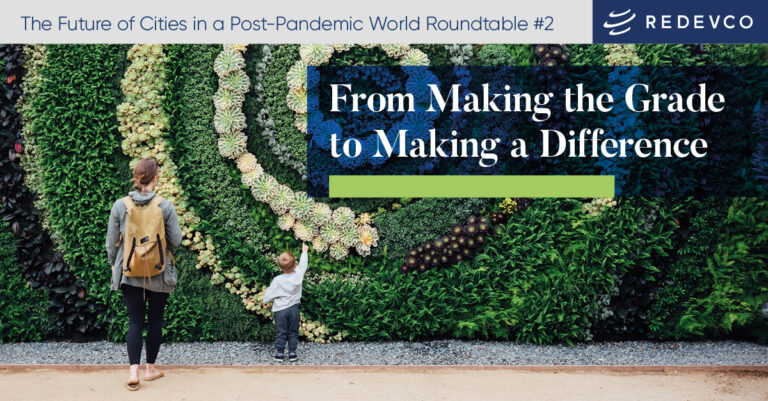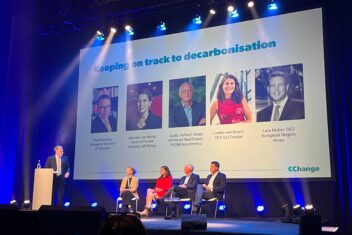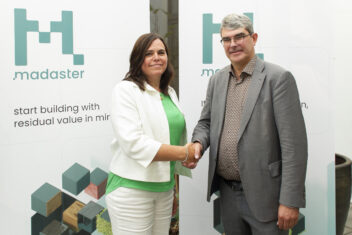Blogpost: Take a Sledgehammer to Obsolete Red Tape and Investment Models Blocking Climate Crisis Innovation and Sustainable New Buildings in Our Cities
July 9, 2021

The Future of Cities in a Post-Pandemic World – From Making the Grade to Making a Difference
Redevco Roundtable #2 on 22 June 2021
The built environment is the primary source of greenhouse gas emissions heating up the planet and our cities are the stage where widening social inequalities are on display, but governments and municipalities are failing to take a sledgehammer to the backward-looking regulation holding back solutions for these two existential crises. Similarly real estate investors, who need to drive the innovation to tackle global climate change and provide affordable homes for urban populations, are not adapting fast enough to the new flood of environmental rules threatening to swamp them. If they don’t, they could be left with a raft of ‘stranded assets’ in their portfolios, speakers at the recent Redevco webinar in a series on The Future of Cities in a Post-Pandemic World, concluded.
Watch the summary video featuring our speakers: Leslie Johnston, CEO of the Laudes Foundation, Clemens Brenninkmeijer, Head of Sustainable Business Operations at Redevco, Xavier Jongen, Managing Director at Catella Residential. Moderator: Judi Seebus, Director at Bellier Financial.
“The tension between environmental and social imperatives is clearly playing out in the built environment. It contributes up to 40% of carbon emissions; it uses 50% of global materials and it requires significant investment to address this. It is something that touches most of us, like the food we eat, the clothes we wear; 90% of our lives are spent in buildings,” Leslie Johnston, CEO of the Laudes Foundation told the webinar: From Making the Grade to Making a Difference.
The Laudes Foundation was launched in 2020 as a philanthropic initiative of the Brenninkmeijer family to respond to what Johnston describes as the biggest challenges of our lifetime: climate breakdown and deepening social inequality. The family’s business interests bundled under COFRA Holding AG encompass, amongst others, the C&A retail chain and Redevco, which is one of Europe’s largest real estate investors in mixed-use urban areas with large retail elements.
“We know that these issues are visible manifestations of a larger problem, a broken global economic system that prioritises profits above all. And this translates into even deeper challenges, whether it’s pervasive short-term thinking, a belief that value is equal to market price, or an inertia that makes it hard to shift the system while the vested interests just dig in,” Johnston said.
The rise of mass migration in reaction to these crises have swept social and racial inequality issues onto global political agendas and are converging with other major trends such as rapid technological change and a fundamental shift in employment patterns, leading to ‘tipping points’ in economies and markets that could transform the world of work and the landscape of the cities we live in, she added.
The real estate industry has an ‘outsize impact’ in the climate and social inequality crises
In her presentation: ‘Our Transformation Imperative,’ Leslie Johnson pointed out that 70% of buildings that will be standing in Europe in the next 30 years already exist, while no less than 97% of buildings constructed before 2010 will require substantial refurbishment to align with the Paris Climate Accords targets of keeping the rise in global temperatures to well below two degrees Celsius above pre-industrial levels.
“EU policymakers are embracing a renovation wave and are even discussing mandatory renovation laws, which would outlaw the worst (sustainability) performers over time. This is a big deal because this would effectively turn them into stranded assets. Specifically, what used to be voluntary, such as companies stepping up and embracing ESG as part of their leadership, will become legally required, as we’re seeing through the mandatory human rights due diligence movement across Europe. This is a very important trend because it makes what may be seen as leadership more of a hygiene factor and also creates a level playing field for companies,” Johnston said.
The built environment is at an early stage when it comes to understanding the impact of the climate transition on local communities and workers, she added.
“Last year, we reached what I would say is a terrifying milestone because it was the year that human-made materials surpassed the weight of all living biomass on the planet. Our cities have become concrete and steel jungles and we need to act.”
Around 10-20% of the CO2 footprint of EU buildings’ is ‘embodied’ carbon and this is not regulated at the asset level across Europe, although the European Commission is considering revising the existing regulations. While some European countries, notably France, the Netherlands and parts of the Nordics, are seeking ways to regulate the whole carbon lifecycle, there is currently no significant market pull from the property sector for low carbon materials. But this could change rapidly, with the 2020s expected to witness the fastest economic transition in history and with €250 billion required each year to upgrade Europe’s existing buildings to meet climate change targets, she said.
Developing the market for financing a net zero carbon transition
The Laudes Foundation has six instruments in its ‘philanthropic toolbox’ that it is using to translate political will into practical action including advocacy, research and data. It has partnered with the Carbon Risk Real Estate Monitor, currently the only science-based pathway for the property sector that helps landlords and investors to understand the stranded asset risk. The organisation is also seeking to unlock funding and investment needed for renovations through a partnership with the Green Finance Institute in the UK and its Coalition for Energy Efficiency of Buildings.
“We are embracing financial innovation to do this. This includes developing the market for financing a net zero transition, putting in place green home finance principles and even developing building renovation passports to put each property on a recorded first proof journey. And if it works, we hope to replicate and scale this across Europe,” Johnston concluded.
Redevco Turns Net Zero Carbon Ambition Into Practical Roadmap
Redevco is stepping up the pace in the implementation of the environmental innovation required in the company’s investments to achieve its ambitious goal of a net zero carbon portfolio by 2040, but there are formidable practical hurdles to surmount and governments need to understand this and tackle outdated market regulations that are slowing the real estate investment industry’s participation in the fight against climate change, Clemens Brenninkmeijer, Head of Sustainable Business Operations at Redevco, told the webinar.
“We are really focusing on this big challenge of climate change and how we can help mitigate that by working and committing towards a net zero portfolio by 2040. But it’s not straightforward — it’s an ambitious goal. What we’ve laid out in our Responsible Investment Report this year is that, during 2020, despite the Covid pandemic and a very difficult business environment, we still managed to make quite a lot of progress in formulating our ambition and what our roadmap will look like in practice. We’re also working on projects that were already in the pipeline and are contributing to the practical steps we need to take and replicate in our portfolio to really drive towards net zero carbon,” Brenninkmeijer said.
He added that there is a danger that real estate investors who take the lead in investing heavily in the decarbonisation of their portfolios would be financially penalised by higher costs weighing on returns, because the market regulatory environment is failing to keep up with the speed and depth of fundamental change required to achieve the EU’s Green Deal climate targets.
“From our perspective, we need to show that net zero buildings are possible to give governments a licence to set more ambitious targets, but they also then need to make sure that there is a level playing field so that the frontrunners who do have the opportunities – as well as the challenges – of being a frontrunner don’t get penalised for that. If they receive support, these companies will start wanting to make a positive contribution and be a force for good on this journey. We are still learning how to balance the impact ambition with our sector’s traditional financial metrics, in other words short-term investment versus longer-term value creation. The desire and ambition are there, but the real challenges are implementation and execution,” he said.
Redevelopments are reducing Redevco’s embodied carbon footprint
Examples of recently completed green redevelopments in the Redevco portfolio include a store in Eindhoven in the south of the Netherlands where the company made a deliberate choice to take the asset off the natural gas grid and focus on energy efficiency by adding solar panels to the roof and working with tenants on highly energy-efficient installations.
“If all the tenants were to choose to procure certified green energy, then this asset would actually be net zero carbon in operation. We’re also working on a big redevelopment in Hamburg to demonstrate what is possible in terms of experimenting with bio-based design, CLT (cross-laminated timber) and other recycled materials in the structure of the building. This will reduce our embodied carbon footprint as well as ensure that the property is zero carbon in operation. It’s all about really raising the bar, going for the highest ambition level possible and showing that it is achievable. Hopefully we can use those insights and understanding to drive future projects,” Brenninkmeijer concluded.
“Capitalism is on Fire,” so Take a Sledgehammer to the Barricades
The low-tech, standard cost solution for accelerating the decarbonisation of the European built environment at scale both in new constructions and existing buildings has already arrived and proven itself in France and by harnessing this self-sufficient positive-energy technology to eradicating domestic electricity bills it also delivers affordable effective rents for residents, Xavier Jongen, Managing Director at Catella Residential told the webinar.
Catella is investing in a €2.0 billion programme to develop 100 of the world’s first energy-positive residential towers across European markets through an exclusive partnership with French building engineering design company Elithis.
The Elithis towers produce more energy than they consume by maximising renewable solar power generation through a ‘photovoltaic skin’ over the buildings’ roofs and facades. The energy efficiency of the design is then boosted further by the ‘human element’ in a bioclimatic management system, where residents are ‘digitally nudged’ to further save money through a smart app to optimise the use of free natural sunlight and ventilation in controlling the temperature of their homes with electronic shutters according to the weather outside. Surplus electricity produced by the towers (currently averaging 108% of consumption) is sold to the national grid and paid back as a bonus in cash to residents who achieve the best sustainable energy management of their homes.
The world’s first self-sufficient energy positive residential tower at scale was developed by Elithis in the French city of Strasbourg in 2018 and Catella has recently acquired the first two projects for its pan-European residential investment platform in Saint Etienne and Dijon, also in France.
“We had been following the prototype for some time before we said it has demonstrated its proof of concept. And this is a technology that’s scalable at no extra construction cost than for a regular building… So you’re adding – no, returning – €1,700 of spending power to the tenants. If we were able to provide this accommodation for the whole of France, the savings would be equal to the national budget for education (6% of French GDP at €2.4 trillion),” Jongen said.
Relationship between risk and return in built environment needs to be redefined
No government subsidies are required to roll out the Catella/Elithis integrated energy positive and affordable rental residential investment model across economies, because the vast ‘moral money’ resources of institutional investors such as pension funds, who need to invest in stable low-risk rental income producing assets while also ensuring they meet high ESG standards for their investment, can be applied to the task.
“You don’t need any extra funding, so the [real estate] industry should step in: institutional investors would be joining an ambitious programme where they’re not losing on return. That’s also an important element – they’re not winning [or making exceptional profits] but they’re not losing either,” Jongen added.
He said the relationship between risk and return in the built environment needs to be reimagined.
“A lot of the time, the negative impact [of business on our environment and society] is neglected in our book-keeping. So where is that negative impact accounted for? It’s not on the financial balance sheet, but effectively you do have a social and environmental return as well as a financial one. By adding a moral balance sheet, you create a [full] stakeholder return concept… “What will it mean for residents in Paris or London if these cities experience more than 20 days of 35 degrees a year? Capitalism is on fire because it does certain things very well and certain things very badly, and the result is climate change and enormous inequalities.”
Jongen added the Elithis technology could also be used to decarbonise other real estate sectors aside from residential. The bioclimatic design has already been applied to offices and could also be used in principle for retail.
“Refurbishments to make existing buildings energy positive are possible but depend on the location, local building restrictions that are already in place or are coming and, of course, pricing. I think the main problem is speed. So, the solution is out there, but what we need is getting (development) plots. And having the building permits swiftly run through the administrative process now. Regulation is part of a democratic process. It’s more backward- looking and this is innovation that by its essence is more forward- looking. So we need to bridge that. I think the biggest bottleneck is not on funding, not on technology, it’s not on ambition. I want to circle back to regulation because I think that’s the real bottleneck.”
Jongen added that there were positive signs that governments were beginning to understand the nature of the regulatory obstacles to the decarbonisation of the built environment, notably in France.
“I have a fantastic positive example of a project that we were able to work through with the person in Bordeaux who was responsible for this case in the French National Development Programme. The gentleman who’s running that has the right to bypass regulation. So that means within a certain environment, the regulation that’s applicable normally doesn’t need to apply within certain conditions. It’s a kind of sledgehammer that can be used to existing regulation that doesn’t fit. And the public administration in this case gave itself the sledgehammer to do that. That’s a very important message that they are sending out so we can speed up the process,” Jongen concluded.
Keep an eye on the Redevco LinkedIn page for more information on the next Redevco roundtable


